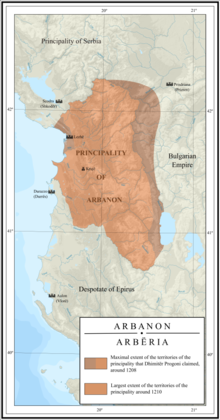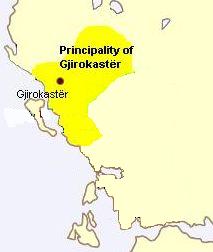Albanian principalities
| History of Albania |
|---|
 |
| Timeline |
The term Albanian Principalities refers to a number of
List of Albanian principalities

- Principality of Arbanon
- Principality of Valona
- Principality of Muzaka
- Despotate of Angelokastron and Lepanto
- Despotate of Arta
- Principality of Balsha
- Principality of Albania (medieval)
- Principality of Gjirokastër
- Principality of Kastrioti
- Principality of Mataranga
- Principality of Dukagjini
- Principality of Gropaj
- Principality of Zahariaj
- Thopia family domains
- Arianiti family domains
Principality of Arbanon

The Principality of Arbanon (1190–1255) was the first Albanian state during the
Despotate of Angelokastron and Lepanto
Despotate of Angelokastron and Lepanto (1358–1374) was a
Principality of Valona
The Principality of Valona (1346–1417) was a medieval state roughly encompassing the territories of the modern Albanian counties of
Principality of Dukagjini
The Principality of Dukagjini (
Despotate of Arta
Despotate of Arta (1355–1416) was a
Principality of Gjirokastër

Principality of Gjirokastër (1373–1418) was a principality created by
Lordship of Berat
The
Kastrioti Principality
Principality of Kastrioti (1389–1444) was one of the most important principalities in Medieval Albania. It was created by
Principality of Topiaj (medieval)
Principality of Albania was an
Principality of Mataranga
The
Principality of Gropaj

The Gropa family was one of the biggest and famous Albanian noble families in the eastern Albania. The dynasty controlled the region between Pogradec, Ohrid and Debar in the period 12th – 14th century.[10] In 1218 a certain Andrea was mentioned as a powerful sebast. In 1273 is mentioned Pal Gropa which once again reconfirmed the domains of the Gropa family and were even given extended privileges by Charles I of Anjou in order to ensure his loyalty. The Gropa noble family ruled until 1395 when it fell under the rapid expansion of the Ottoman Empire.
Principality of Zahariaj
The first ruler of the
See also
References
- ^ ISBN 99927-1-623-1
- ^ a b John V.A. Fine Jr., The Late Medieval Balkans, Ann Arbor, 1987.
- ^ a b The Oxford Dictionary of Byzantium, Oxford University Press, 1991.
- ^ Imber 2019, p. 152.
- ^ a b James Emerson Tennent, 1845, The History of Modern Greece, from Its Conquest by the Romans B.C.146, to the Present Time
- ^ History of the Decline and Fall of the Roman Empire, Volume 6, Scanderbeg section
- ^ Minna Skafte Jensen, 2006, A Heroic Tale: Marin Barleti's Scanderbeg between orality and literacy Archived 19 July 2011 at the Wayback Machine
- ^ Dimiter Angelov: Imperial Ideology and Political Thought in Byzantium, 1204-1330. p. 319.
- ^ Vlora 1956, 5. Gropa Archived 27 January 2012 at the Wayback Machine: "The sphere of influence of the Gropas was no doubt concentrated in the region between Pogradec, Ohrid and Dibra. They seem to have ruled in that area for two centuries"
- OCLC 249799501,
Na papiru ili pergameni predaje Djurdje tom zgodom Mlečanima i »grad Sati s carinom na Danju«. Ali dočim Skadar i Drivast domala i bez zapreke preuzimaju mletački provedituri, mali gradići u gudurama Drina, Danj i Sati, ostaju za njih Tih mjesta, u kojima 1395 vlada Kostadin Balšić, ne će izručiti njegov kaštelan, Arbanas Coya Zaccaria. On se poslije nazivao »dominus Sabatensis et Dagnensis« i bio čas turski kletvenik, čas mletački saveznik.
- ^ Bešić 1970, p. 78
У октобру 1400. год. један скадарски фрањевац упознао јемлетачку владу са жељом Ко је Закарије да се приклони Млеча-нима, јер је турску власт прихватио наводно из нужде, и да засличан став придобије свог рођака Димитрија Јониму. Као господар Дања и Шатија, ... Предлагао је да се инсценира сукоб у коме би га Млечани побиједшш и ... Сам је као награду тражио млетачку провизију од 500 дуката годишње. Упркос привлачности понуде,Млечани су одложили коначну одлуку, поготову када се послијенеколико дана сазнало да је и сам. Која већ отишао султану.)
- ^ Bešić 1970, p. 158
Коју Закарију је или протјерао или заробио, а Дањ повјерио Али-бегу.)
- ^ Bešić 1970, p. 160
Када је арбанаски устанак скршен, султан је ... Предао је Дањ сину Које Закарије — Леки,)
Bibliography
- Bešić, Zarij M. (1970), Istorija Crne Gore / 2. Crna gora u doba oblasnih gospodara (in Serbian), Titograd: Redakcija za istoiju Crne Gore, OCLC 175122851
- Imber, Colin (2019). The Ottoman Empire, 1300-1650: The Structure of Power. Macmillan International Higher Education. ISBN 978-1352004144.
- Trnavci, Gene (2010). Mortimer Sellers (ed.). The interaction of customary law with the modern rule of law in Albania and Kosova. Springer. p. 205. ISBN 978-9048137497.
- "History of Albanian People" Albanian Academy of Science. ISBN 99927-1-623-1
- The American Slavic and East European Review 1952. 1952. ASIN 1258092352.
